Process Notebook
Stackoverflow Analysis and Tag Prediction
Team Members:
- Neetha Jambigi
- Subash Prakash
- Tirtha Chanda
1 Overview and Motivation:
With the advent of web, we have quick access to vast number of people’s knowledge through Q&A forums like stack overflow, Quora etc. We have chosen Stack Overflow, the most popular and global online Q&A forum for technology as our topic. This forum covers a vast range of domains and technologies and is a go-to forum for seeking solutions w.r.t. old and new technologies. This forum has an overwhelming number of users and activities for the technical domain. As we use Stack Overflow in our day-to-day activities, the results for us will be relatable.
We intend to use several components and features of Stack Overflow, to gain an overview of a very small section of the posts. They have queries, answers and comments . Posts have attributes amongst which tags are one of the most important ones. Tags are keywords which broadly identify the domain the post belongs to. It enhances the searchability and visibility of the post to appropriate audiences for the post among others. The paper [Bhat et al] demonstrates the importance of tags in stackoverflow. They model the answer time prediction based on two groups of features of which 1 is tag based. A new user who is not well versed with the platform may not be able to enjoy full benefit of the forum due to lack of fundamental information on usage. In such a scenario, tag recommendation comes as a helpful tool. This being our motivation, through this project, we have attempted to recommend 1-most appropriate tag for a post based on the textual content and the title of the post.
We have experimented with several approaches to model this data to exploit the textual content of the posts to obtain a tag recommendation. Also we have performed data exploration in an attempt to identify correlations in the data if any. The sections that follow in this report have details with supporting visualizations for our EDA results.
2 Data :
2.1 Source
We can obtain the data dumps from which we can extract features as needed. They are publicly available and hosted on https://archive.org/download/stackexchange
The names of the datasets we plan to use are: stackoverflow.com-Posts.7z stackoverflow.com-Comments.7z stackoverflow.com-Users.7z stackoverflow.com-Tags.7z
Links:
- https://archive.org/download/stackexchange/stackoverflow.com-Comments.7z
- https://archive.org/download/stackexchange/stackoverflow.com-Posts.7z
- https://archive.org/download/stackexchange/stackoverflow.com-Tags.7z
- https://archive.org/download/stackexchange/stackoverflow.com-Users.7z
These files contain the actual posts from stack overflow website(queries, solution, etc.). They are cross-referenced in comments using the UniquePostID. The StackOverflow.com posts have several components of which we have considered the following: Questions & answers, Comments( for questions and answers), Users
2.2 Structure of Stack Overflow Posts
A short introduction to structure of stack Overflow posts to set the context for the documentation ahead :
- They consist of 3 kinds of texts the users can post : Questions, Answers and Comments.
- Question posts have Title and Body.
- Answers also have the question ID they belong to.
- Comments can belong to questions or answers.
- These posts are voted up or down. This cumulative of upvote and downvote is the score a post obtains.
- All kinds of posts can be voted and hence have scores.
- Views is the number of times the question was viewed by the users.
- Posts have tags that can be used to reference them to particular areas.
In our case, tags become the classes /categories/label that we attempt to predict for an incoming post.
2.3 Data Pre-processing :
Extraction and XML parsing:
- Extraction of these zip files, provides the respective XML files.
- XML files are parsed in R and the respective CSV’s are created.
2.3.1 Posts.csv :
The original extracted Posts file contains approximately 70 GB of data Hence we take only the last 499,999 records (most recent data) by using the command on the Linux terminal. To create Posts.csv, an XML parser in the R library “XML” was used to import the data into a DataFrame. Then, the DataFrame was exported as a csv.
This list of post Identifiers (ID) from posts.csv was used for matching and extracting relevant entries from the comments file.
2.3.3 Users.csv
All users given by the dataset were used. XMl file was processed similar to others to obtain a csv.
On the whole, our dataset consists of posts for a span of 3 months dating back from October,2018
Steps to Final Dataframe Data Cleaning : Only posts that have tags are selected. Question and answer posts are separated. Only 1 tag per post from the tags columns for questions is retained. The post body is extracted and cleaned to remove html tags. Links and code parts of the post body are extracted to create new columns “hasLinks” and “hasCode”.
4 Initial Questions
We set out to answer the following questions with our project
* In which parts of the world is Stack Overflow mostly used?
* What are the top 10 common categories?
* What is the overall sentiment of users grouped by topic?
* What are the most upvoted question tags?
* Is sentiment of answers/comments correlated with the number of upvotes or downvotes?Through the course of the project, we were able to answer the questions we initially intended to. In the following EDA section, we have answered these questions. However, the data did not really exhibit any strong correlations, reason being the time period the data spanned was too small.
5 Exploratory Data Analysis
Exploratory data analysis was performed on all the components of the data set. Following are the sections of the EDA:
- USERS
- QUESTION
- TAGS
- CORRELATIONS
5.1 User Data :
User data has been visualised based on the attributes of the users profiles.
5.1.1 Users by Geography :
Plotting Users locations on a map
plot_geo(locations, sizes = c(1, 500)) %>%
add_markers(
x = ~lon, y = ~lat, size = ~n, color = ~n, hoverinfo = "text",
text = ~paste(locations$Location)
) %>%
layout(title = 'User Locations', geo = g)5.1.2 Gender Distribution :
The users’ gender distribution for stack overflow.
ggplot(genders, aes(x = factor(1), fill = factor(gender))) +
geom_bar(width = 1) +
coord_polar(theta = "y") +
labs(x = "", y = "", title = "Gender Distribution") +
scale_fill_manual(name = "Gender", values=c("brown3", "slateblue")) +
theme_bw() +
theme(axis.title.x=element_blank(),
axis.text.x=element_blank(),
axis.ticks.x=element_blank())
Gender information is not available in our stack Overflow users file. The gender is inferred based on names of the users using gender library to obtain an overview of gender distribution for male-female users of the portal in our data. Only less than a quarter of the users are female.
5.1.3 Word Cloud of Users’ AboutMe Sections :
dfm_aboutme <- users$TidyAboutMe %>%
quanteda::tokens() %>%
dfm() %>%
dfm_trim(min_termfreq = 10, verbose = FALSE)
# plot a wordcloud
set.seed(100)
textplot_wordcloud(dfm_aboutme, max_words = 200, rotation = 0.25,
color = c('blue', 'green', 'purple'))
This forum encompasses users of various domains. This is visualization of “About me” section from the users profiles, to obtain most prominent words using a word cloud. This helps see what areas and skills are dominant based on the users who have provided the details.
Dominant skill as seen is programmer. There are a number of positive words about the inclination of the users to technology.
5.2 Questions :
5.2.1 Wordcloud for Question Titles Overall
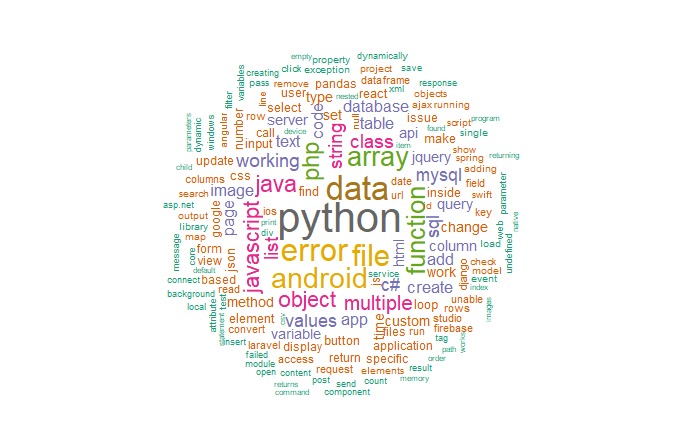
5.2.2 Wordcloud for Bi-grams in Question Titles
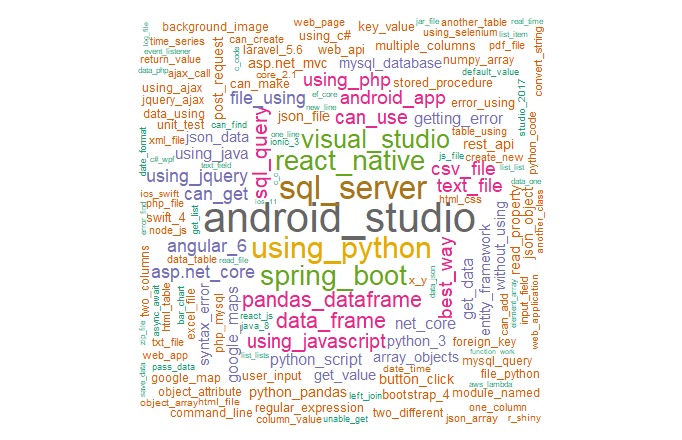
5.2.3 Frequently Co-occurring Nouns in Questions
# create a cooccuring terms graph
desc_word_pairs %>%
filter(n >= 160) %>%
graph_from_data_frame() %>%
ggraph(layout = "fr") +
geom_edge_link(aes(edge_alpha = n, edge_width = n), edge_colour = "cyan4") +
geom_node_point(size = 2) +
geom_node_text(aes(label = name), repel = TRUE,
point.padding = unit(0.2, "lines")) +
labs(title="Most Co-occuring Words in Questions") +
theme_void() +
theme(plot.title = element_text(hjust = 0.5)) This co-occuring terms visualization was an attempt at understanding if co-occuring words can be a factor for predicting tags. It can be seen that when we follow the highly frequent edges in the graph, we can form pseudo questions.
This co-occuring terms visualization was an attempt at understanding if co-occuring words can be a factor for predicting tags. It can be seen that when we follow the highly frequent edges in the graph, we can form pseudo questions.
5.2.4 Boxplot of View Counts for Questions of each Tag
# plot question ViewCount for each tag
ggplot(questions, aes(x = Tags, y = ViewCount, fill = Tags)) +
geom_boxplot() +
scale_y_continuous(limits = c(0, 200)) +
labs(title = "Question View Counts per Tag", y = "View Count", x = NULL) +
#theme_bw() +
theme(axis.text.x = element_text(face = "bold", size=12, angle = 60),
axis.text.y = element_text(face = "bold", size=12, angle=0),
plot.title = element_text(size=15), legend.position="none") +
scale_fill_discrete(name = "Tags")## Warning: Removed 499 rows containing non-finite values (stat_boxplot).
View counts distribution for questions from each tag. C and C++ questions tend to get viewed more often than others. This could be due to the extremely large user base of c and c++. JQuery questions get the least amount of views.
5.2.5 View Counts v/s Scores for Questions
# ViewCount Score correlation
questions %>%
# remove a few outliers
filter(Score < 100) %>%
ggplot(aes(Score, ViewCount)) +
geom_jitter(color='firebrick4', size = 0.4) +
# fit a regression line
geom_smooth(method='lm') +
# scale the y axis
scale_y_log10() +
scale_x_continuous(breaks = pretty(questions$Score, n = 50)) +
labs(title = "Plot of Question View Counts and Scores",
y = "View Counts", x = "Score") +
theme_bw() +
theme(axis.text.x = element_text(face = "bold", size=12, angle = 60),
axis.text.y = element_text(face = "bold", size=12, angle=0),
plot.title = element_text(size=15), legend.position="none")
The plot is suggestive of a postive correlation between the scores and views of questions. There could be a causal relationship between these two as well. High scored questions may appear in Google searches more often, and in turn get more views.
5.2.6 Time Series of Frequency of Questions
Here we have considered the data from 2017 to examine the progression of the number of question for a few tags over a month.
# time series for dec 17
p1 <- dec17 %>%
filter(Tags %in% c('python', 'javascript', 'java', 'c#', 'android')) %>%
group_by(Tags) %>%
ggplot(aes(x = date, y = n, color = Tags)) +
geom_line() +
geom_text(aes(label=day),hjust=0, vjust=0, size=1.8) +
labs(x = "Date", y = "Count",
title = "Number of Questions per Day for December 2017") +
theme(axis.text.x = element_text(angle = 60, vjust = 0.5)) +
scale_x_date(date_breaks = "2 days", date_labels = "%b %d")
# time series for jan 18
p2 <- jan18 %>%
filter(Tags %in% c('python', 'javascript', 'java', 'c#', 'android')) %>%
group_by(Tags) %>%
ggplot(aes(x = date, y = n, color = Tags)) +
geom_line() +
geom_text(aes(label=day),hjust=0, vjust=0, size=1.8) +
labs(x = "Date", y = "Count",
title = "Number of Questions per Day for January 2018") +
theme(axis.text.x = element_text(angle = 60, vjust = 0.5)) +
scale_x_date(date_breaks = "2 days", date_labels = "%b %d")
# plot combined time series
grid.arrange(p1, p2)
This plot shows a pattern of the number of question dipping during the weekend while being the highest during weekdays. This pattern is commonly observed for questions of all Tags. This observation is inline with active working days patterns in most countries worldwide. Also during the end of December is observed as a holiday period and there is decrease in the number of question as compared to the month of January.
5.4 Correlations
This section consists of some correlation that were discovered in the data as a part of the EDA :
5.4.1 Correlation between different Features of the Questions
###### Correlations ###############
library(corrplot)
score_questions <- questions %>%
arrange(desc(Score)) %>%
select(Score,AnswerCount,CommentCount,FavoriteCount)
scoresCol <- cor(score_questions)
corrplot(scoresCol, method="color",
type="lower", order="hclust",
addCoef.col = "black", # Add coefficient of correlation
tl.col="black", tl.srt=0, #Text label color and rotation
# hide correlation coefficient on the principal diagonal
diag=FALSE )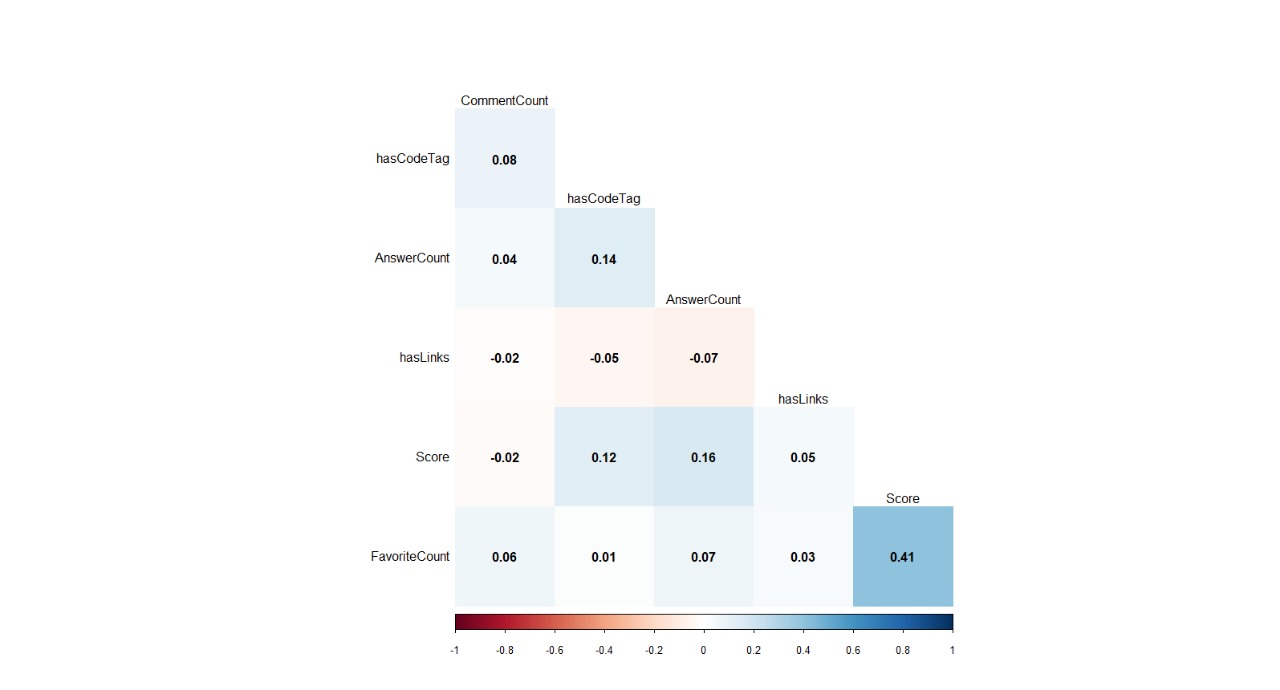
The highest correlation can be seen between favorite count (where users mark it as a bookmark) and scores. However these correlations are suggestive of a small part of stack overflow data. On a larger representative data, we might be able to get actual correlations.
6 Predictive Modelling
6.1 Text Pre-processing
Our analysis is focused on recommending 1 tag per incoming post . For learning a model, we acquired posts that have tags associated with them. Hence our data used for modeling consists of only posts that are type questions. Mainly textual columns are title and post body. Post Body is further processed to extract the text corresponding to URL and Code to create two separate columns.
The remaining post body and title undergoes the text preprocessing steps:
- Stop words are removed,
- White spaces are removed
- Contractions are expanded
- Converted to Lower case
- Number and Punctuations
- Stemming
- Lemmatization
Post Body : The post body has been cleaned to exclude the URL content, code content. The post body now contains solely of the text description of the problem/query that the user has presented. This text is predominantly short natured.
We have tried to obtain terms that could be influential for building classification models.Approaches to obtaining top-terms after elementary text preprocessing :
- TF-IDF - To remove the terms that are too common but do not belong to the set or stop words removed
- POS-tagging to obtain nouns - Most indicative and helpful terms for tag prediction are the nouns in the post. Hence, we could extract only nouns from a post and thereby reducing the total number of words
- Term frequencies - plain counts of the terms in the documents
The post is now represented by reduced numbers of terms in comparison to original post. We convert them into term-document matrix to feed as input to the classification models. The vectors could be :
- Term Frequencies
- Tf-idf weights for top terms
- Tf-idf weights for top Nouns
6.1.1 Following is the visual of top 15 words from just the titles of the posts :
Word Cloud of Top 15 TfIdf on Title
##Select top words of tf_idf ###########
tag_words %>%
arrange(desc(tf_idf)) %>%
mutate(word = factor(word, levels = rev(unique(word)))) %>%
group_by(Tags) %>%
top_n(15) %>%
ungroup %>%
ggplot(aes(word, tf_idf, fill = Tags)) +
geom_col(show.legend = FALSE) +
labs(x = NULL, y = "tf-idf top 15 words") +
facet_wrap(~Tags, ncol = 5, scales = "free") +
coord_flip()Top 15 tf-idf weighted words for each tag from post titles 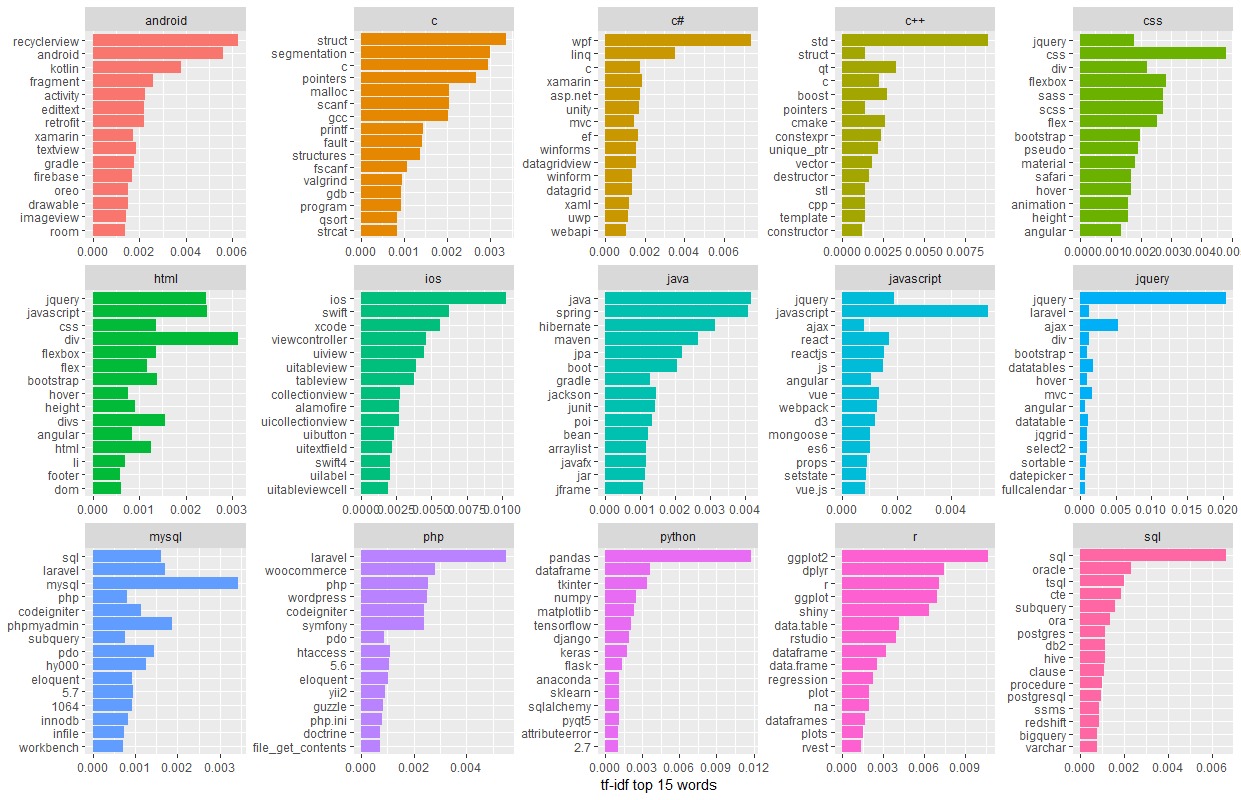
6.2 Modelling Techniques for Tag-Prediction
We have used classification and topic modelling for our tag-prediction task.
Classifiers of choice:
- SVM
- Multinomial Naive Bayes
- Nearest Mean Classifier (supervised clustering)
Topic Modelling :
- LDA
Following is the brief on our choices for modelling :
6.2.1 Nearest Mean:
We pursued this supervised approach to clustering due its very quick runtimes and we used this to get a brief view of data. This gave us an acceptable accuracy during our first few trials and hence the variance of the data was not so much that it would lead to really bad results.
This methos creates a cluster our of every class and then maps the incoming instance to its nearest cluster and assigns that as the class to the new instance
- Library : Klar
- Input : term- document matrix with tf-df weights
6.2.2 SVM :
SVM being one of the most powerful classifiers there is, has been shown to work well with text classification tasks [Joachims][Basu et al]. As the text already is high dimensional data, its shown in [Kaestner] that linear kernel is computationally cheap and efficient for text classification.
SVM is a binary classifier which derives decision boundary between classes. Hence, we have implemented a one-versus-rest for each class. We have gained similar accuracies for a polynomial kernel with degree 2 and linear kernel. Hence, a linear kernel is almost as effective and much cheaper than a polynomial one in our case as well.
- Library : E1071
- Input to the model : Term-document matrix with tf-idf weights for nouns extracted posts body
- Visualisation : Chord diagram for misclassification
6.2.3 Multinomial Naive Bayes:
This is an obvious choice for being efficient, simple and a straight forward approach to text classification problem [Ting et. al]. Naive Bayes has been proven to work well on text time and again. Eventhough assumption of independence of features may remove the contextual information, this is fast and efficient and its an acceptable trade-off for our case of tag prediction. In this classifier the maximum posterior probabilty from the probabilites for all classes is chosen to be the class of instance in question.
- Library : Quanteda
- Input to the model : Term-document matrix with tf-idf weights for nouns extracted posts
- Visualisation : Chord diagram for misclassification
We have chosen LDA to perform topic-modelling on our data
6.2.4 LDA :
Latent Dirichlet Allocation is an example of topic modelling and is used to classify text in questions (Title) into various topics(Tags) which are modelled as Dirichlet distributions. The operations performed to apply LDA are: The set of title text are grouped by Tag TFIDF is applied to the large text collection per Tag Top n words from TFIDF is choosen and document-term-matrix is created. Using this, LDA with K=15 (topics) is applied. For an unseen data, the model of LDA applies probablities to allocate it to most appropriate topic.
An observation that could be seen is that, LDA will depend on the entire data being passed and judges based on it.
A chord diagram is created to understand the source and topic relationship. This visualization is a key for LDA analysis and also to understand the overall text data.
- Library: topicmodels
- Input: K = Number of Topics, Data = Document-Term-Matrix
- Visualization Library: circos, knitr, ggplot2
6.3 Visualizing Classifier Performance
This chord diagram for the classifiers are here indicating the tags’ misclassification relationship - (html and javascript getting mutually misclassified into each other). This could be the impact of common vocabulary these languages share. As they tend to be used together, they also appear together in the same question a lot. Due to pursuing modeling based on the textual content of the posts, this result was anticipated. To alleviate this issue, we can model ensemble of classifiers, modeling both stack-overflow related features and textual content.
6.3.1 SVM :
cols = c("red", "blue", "purple", "pink", "orange", "green", "steelblue1",
"green4", "cyan", "royalblue", "magenta", "yellow", "steelblue4", "blue4", "olivedrab")
# svm chord diagram
chordDiagram(svm_class_table, grid.col = cols)
This model classified most of CSS questions as HTML, most of Jquery questions as javascript. Majority of HTML misclassification comprises of being classified into javascript. These languages tend to be used together frequently and perhaps be part of same question many times.
6.3.2 Multinomial Naive Bayes:
cols = c("red", "blue", "purple", "pink", "orange", "green", "steelblue1",
"green4", "cyan", "royalblue", "magenta", "yellow", "steelblue4", "blue4", "olivedrab")
# naive bayes chord diagram
chordDiagram(nb_class_table, grid.col = cols)
Similarly the misclassfications in the Naive Bayes can be attributed to languages being used together more often than not are confused as one another.
6.3.3 LDA :
#main function that draws the diagram. transparancy goes from 0-1
chordDiagram(source_topic_relationship, transparency = 0.5,
preAllocateTracks = list(track.height = 0.09), grid.col = grid.col)
title("Relationship Between Topic and Source")
#Clear the circos plot
circos.clear()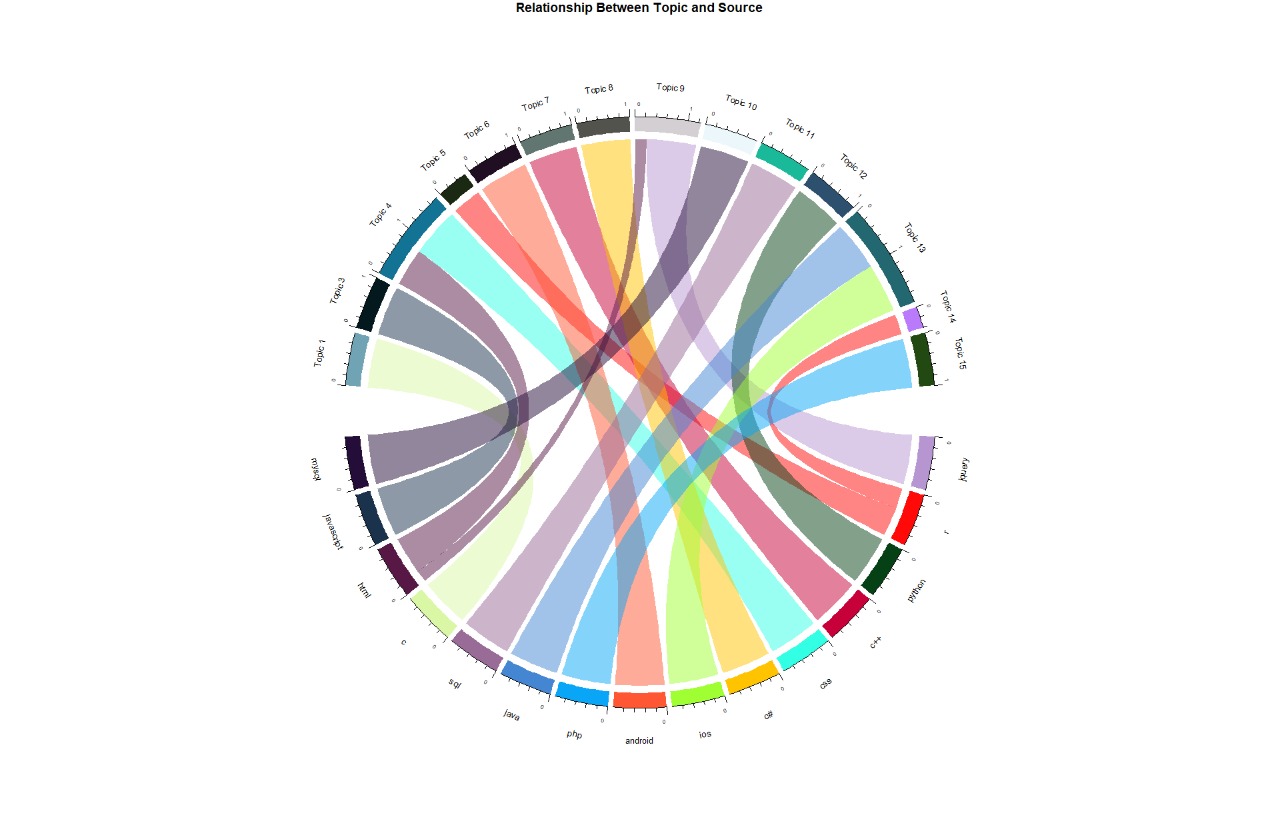
So, also is the case with LDA where it mixes up words from HTML and CSS into topic 4, Topic 9 consists of a small part of HTML words and Jquery.
The Misclassification patterns are similar across all the models. This can be addressed by identifying better discriminator vocabularies for co-occuring technologies. * Considering tf-idf based filtering of words for the co-occuring technologies to eliminate common words between technologies.
6.4 Performances
We have made 80-20 train-test split. All the classifiers were trained on the nouns extracted from the posts. And converted them into TF-IDF vectors to be used as instances training and testing.
Parameters:
- SVM : default parameters with kernel set to Linear
- Naive Bayes : defaults
- Nearest Mean : defaults
Training times: Longest to shortest
- SVM
- Nearest Mean
- Naive Bayes
Best Accuracies:
- SVM - ~ 73%
- Naive Bayes - ~ 69%
- Nearest Mean - ~ 63%
The detailed tabulation of the classifiers’ performance also has been added in the following section. There we can see what was the performane for each class for a classifier.
6.4.1 SVM Linear
confusion_matrix_svm$overall[1:4] %>% round(2)## Accuracy Kappa AccuracyLower AccuracyUpper
## 0.73 0.70 0.72 0.74knitr::kable(confusion_matrix_svm$byClass %>% round(2))| Sensitivity | Specificity | Pos Pred Value | Neg Pred Value | Precision | Recall | F1 | Prevalence | Detection Rate | Detection Prevalence | Balanced Accuracy | |
|---|---|---|---|---|---|---|---|---|---|---|---|
| Class: android | 0.89 | 0.99 | 0.91 | 0.98 | 0.91 | 0.89 | 0.90 | 0.14 | 0.12 | 0.13 | 0.94 |
| Class: c | 0.61 | 0.99 | 0.41 | 1.00 | 0.41 | 0.61 | 0.49 | 0.01 | 0.01 | 0.01 | 0.80 |
| Class: c# | 0.87 | 0.98 | 0.77 | 0.99 | 0.77 | 0.87 | 0.82 | 0.08 | 0.07 | 0.09 | 0.93 |
| Class: c++ | 0.59 | 0.99 | 0.75 | 0.98 | 0.75 | 0.59 | 0.66 | 0.05 | 0.03 | 0.04 | 0.79 |
| Class: css | 0.75 | 0.97 | 0.03 | 1.00 | 0.03 | 0.75 | 0.05 | 0.00 | 0.00 | 0.03 | 0.86 |
| Class: html | 0.48 | 0.96 | 0.57 | 0.95 | 0.57 | 0.48 | 0.52 | 0.10 | 0.05 | 0.08 | 0.72 |
| Class: ios | 0.93 | 0.99 | 0.78 | 1.00 | 0.78 | 0.93 | 0.85 | 0.04 | 0.04 | 0.05 | 0.96 |
| Class: java | 0.87 | 0.98 | 0.79 | 0.99 | 0.79 | 0.87 | 0.83 | 0.09 | 0.07 | 0.09 | 0.92 |
| Class: javascript | 0.60 | 0.95 | 0.72 | 0.93 | 0.72 | 0.60 | 0.66 | 0.16 | 0.10 | 0.13 | 0.78 |
| Class: jquery | 1.00 | 0.98 | 0.01 | 1.00 | 0.01 | 1.00 | 0.01 | 0.00 | 0.00 | 0.02 | 0.99 |
| Class: mysql | 0.64 | 0.98 | 0.29 | 1.00 | 0.29 | 0.64 | 0.40 | 0.01 | 0.01 | 0.03 | 0.81 |
| Class: php | 0.64 | 0.98 | 0.77 | 0.97 | 0.77 | 0.64 | 0.70 | 0.07 | 0.05 | 0.06 | 0.81 |
| Class: python | 0.83 | 0.97 | 0.87 | 0.96 | 0.87 | 0.83 | 0.85 | 0.18 | 0.15 | 0.17 | 0.90 |
| Class: r | 0.77 | 0.99 | 0.73 | 0.99 | 0.73 | 0.77 | 0.75 | 0.04 | 0.03 | 0.04 | 0.88 |
| Class: sql | 0.49 | 0.99 | 0.78 | 0.98 | 0.78 | 0.49 | 0.60 | 0.04 | 0.02 | 0.02 | 0.74 |
# svm confusion matrix visual
qplot(y_test, predictions_svm, colour=y_test, size=I(0.01), geom = c("boxplot", "jitter"),
main = "SVM Predicted Classes vs Observed", xlab = "Observed", ylab = "Predicted") +
theme_bw() +
theme(axis.text=element_text(size=12),
axis.text.x = element_text(face = "bold", size=10, angle = 30),
axis.text.y = element_text(face = "bold", size=10, angle=30),
plot.title = element_text(size=15), legend.position="none")
6.4.2 Multinomial Naive Bayes
confusion_matrix_nb$overall[1:4] %>% round(2)## Accuracy Kappa AccuracyLower AccuracyUpper
## 0.70 0.67 0.70 0.70knitr::kable(confusion_matrix_nb$byClass %>% round(2))| Sensitivity | Specificity | Pos Pred Value | Neg Pred Value | Precision | Recall | F1 | Prevalence | Detection Rate | Detection Prevalence | Balanced Accuracy | |
|---|---|---|---|---|---|---|---|---|---|---|---|
| Class: android | 0.89 | 0.98 | 0.88 | 0.98 | 0.88 | 0.89 | 0.88 | 0.13 | 0.12 | 0.13 | 0.93 |
| Class: c | 0.30 | 1.00 | 0.82 | 0.97 | 0.82 | 0.30 | 0.44 | 0.04 | 0.01 | 0.01 | 0.65 |
| Class: c# | 0.88 | 0.98 | 0.74 | 0.99 | 0.74 | 0.88 | 0.80 | 0.07 | 0.06 | 0.09 | 0.93 |
| Class: c++ | 0.75 | 0.99 | 0.69 | 0.99 | 0.69 | 0.75 | 0.72 | 0.04 | 0.03 | 0.04 | 0.87 |
| Class: css | 0.30 | 0.99 | 0.69 | 0.96 | 0.69 | 0.30 | 0.42 | 0.06 | 0.02 | 0.03 | 0.65 |
| Class: html | 0.47 | 0.94 | 0.34 | 0.97 | 0.34 | 0.47 | 0.40 | 0.06 | 0.03 | 0.08 | 0.71 |
| Class: ios | 0.91 | 0.99 | 0.83 | 1.00 | 0.83 | 0.91 | 0.86 | 0.04 | 0.04 | 0.05 | 0.95 |
| Class: java | 0.82 | 0.98 | 0.79 | 0.98 | 0.79 | 0.82 | 0.80 | 0.09 | 0.07 | 0.09 | 0.90 |
| Class: javascript | 0.77 | 0.93 | 0.50 | 0.98 | 0.50 | 0.77 | 0.61 | 0.09 | 0.07 | 0.14 | 0.85 |
| Class: jquery | 0.26 | 0.99 | 0.72 | 0.96 | 0.72 | 0.26 | 0.38 | 0.05 | 0.01 | 0.02 | 0.63 |
| Class: mysql | 0.46 | 0.98 | 0.40 | 0.99 | 0.40 | 0.46 | 0.43 | 0.02 | 0.01 | 0.03 | 0.72 |
| Class: php | 0.66 | 0.98 | 0.76 | 0.97 | 0.76 | 0.66 | 0.70 | 0.07 | 0.05 | 0.06 | 0.82 |
| Class: python | 0.94 | 0.95 | 0.74 | 0.99 | 0.74 | 0.94 | 0.83 | 0.14 | 0.13 | 0.17 | 0.94 |
| Class: r | 0.64 | 1.00 | 0.91 | 0.98 | 0.91 | 0.64 | 0.75 | 0.06 | 0.04 | 0.04 | 0.82 |
| Class: sql | 0.47 | 1.00 | 0.85 | 0.98 | 0.85 | 0.47 | 0.61 | 0.04 | 0.02 | 0.02 | 0.73 |
qplot(test_y_nb, predictions_nb, colour=test_y_nb, size=I(0.01), geom = c("boxplot", "jitter"),
main = "Naive Bayes Predicted Classes vs Observed",
xlab = "Observed", ylab = "Predicted") +
theme_bw() +
theme(axis.text=element_text(size=12),
axis.text.x = element_text(face = "bold", size=10, angle = 30),
axis.text.y = element_text(face = "bold", size=10, angle=30),
plot.title = element_text(size=15), legend.position="none")
6.4.3 Overall
ggplot(melt(all_scores), aes(fill=Model, y=value, x=variable)) +
geom_bar(position="dodge", stat="identity", width = 0.4) +
scale_y_continuous(breaks = seq(0, 1, len = 30) %>% round(2)) +
labs(x = "", y = "", title = "Accuray and Kappa Scores for 3 Classifiers") +
theme_bw() +
theme(axis.text=element_text(size=12),
axis.text.x = element_text(face = "bold", size=15),
axis.text.y = element_text(face = "bold", size=10),
plot.title = element_text(size=15))## Using Model as id variables
6.5 Testing On Unseen New Data
Ground Truth Evaluation:
For naive bayes classifier and LDA we have also incorporated approaches to test the built model over unseen data against the ground truth created.
Creation of ground truth:
About 39 questions were extracted for the selected tags namely python,r,java,javascript,ios,c,mysql. Using www.stackoverflow.com, we went and extracted the title and tag related to a question. Two criteria were choosen for select a question that is, * It is well featured question so that there are answers and we are sure that there is high chance of Tag being in the title. * Unanswered question titles are extracted to know why they are not answered.
Statistics of the number of questions tested on:
testing_csv_1 <- read_csv("plots/Testing_q_stats.csv", col_names = TRUE)
knitr::kable(testing_csv_1)| Tags | QuestionsTotal | LDA | NB |
|---|---|---|---|
| r | 6 | 5 | 4 |
| python | 5 | 3 | 4 |
| java | 5 | 4 | 4 |
| mysql | 5 | 0 | 4 |
| ios | 6 | 3 | 3 |
| c | 7 | 4 | 5 |
| javascript | 5 | 0 | 1 |
| Total | 39 | 19 | 25 |
Actual questions used for testing and the predictions for LDA and Naive Bayes. This table also shows the ground truth for the questions.
testing_csv_2 <- read_csv("plots/Testing.csv", col_names = TRUE)
knitr::kable(testing_csv_2)| Question Title | Category | Ground Truth Labels | LDA Predicted | NB Predicted |
|---|---|---|---|---|
| Unable to convert YY-mm generated by zoo package , to Date format in R | New | r | r | r |
| How find code of the function in R package code? | New | r,rstudio | r | r |
| Get index of element in unfiltered vector | New | r | c++ | python |
| Cannot log-in to rstudio-server | Unanswered | r,rstudio | r | python |
| R Shiny withProgress Indicator Within Fluid Container | Unanswered | r,shiny | r | r |
| R: Should keys behave this way in data.table? | Unanswered | r | r | r |
| Make IDE/linter ignore a seemingly unused import | New | pycharm,python | android | python |
| Tensorflow to ONNX conversion | New | tensorflow,python | python | python |
| python-pdfkit (wkhtmltopdf) TOC overflow | Unanswered | python,xslt | python | css |
| Python sign SOAP request using BinarySecurityToken | Unanswered | python,soap | python | python |
| Tkinter to android translation | Unanswered | android,python | android | android |
| Why int data type is behaving like this in JAVA? | Unanswered | java,datatype | java | java |
| Why expression inside map() function executed only when using count() function? | New | java-8,java | android | r |
| Spring @Configuration runtime injection | Unanswered | java,spring | java | java |
| Define Mongo Schema Validation using Spring | Unanswered | java,spring,mongo | java | java |
| How to make Multi-Release JAR Files with Gradle? | Unanswered | java,gradle | java | java |
| How to have custom upgrading script on Wordpress Website? | Unanswered | mysql | php | php |
| Get only 1 result per group of ID | New | mysql | android | mysql |
| MySQL fabric server error when adding group | Unanswered | mysql,mysql-fabric | php | mysql |
| Mysql 5.7 Could not create unix socket lock file | Unanswered | mysql,unix | php | mysql |
| Why this query explain not contains “using where” | Unanswered | mysql | android | mysql |
| What is the best practices to work with forms in ReactJS? | New | javascript,reactjs | android | php |
| How to update arrays in a vue.js loop reactively? | NEw | javascript,vuejs | android | python |
| Populate Dropdown based on location tags | New | javascript,php | html | jquery |
| How to get md5 iterated md5 sum of every chunk, using blueimp jquery upload plugin | Unanswered | javascript,jquery | html | php |
| jQuery Ajax post request stuck on pending on Chrome | Unanswered | javascript,ajax | html | javascript |
| UIView is not scrollable inside scrollview | New | ios | ios | ios |
| Passing data using NotificationCenter in swift | New | ios,swift | ios | ios |
| Display activity indicator with RxSwift and MVVM | New | ios,swift | android | ios |
| Stick three containers and a problem with iPhone X | New | ios | android | javscript |
| How to integrate app with iOS Contacts app? | New | ios | ios | android |
| Thumbnail Metadata Disappeared When Importing File with Copy to App | Unanswered | ios | android | android |
| C Segmentation fault function refrence | New | c | c | c |
| snprintf usage for making up formatted strings | New | c | android | c++ |
| Malloc memory check if contiguous | New | c | c | c |
| CPython - locking the GIL in the main thread | Unanswered | c,python | android | python |
| Is it a good idea to typedef pointers? | New | c | c | c++ |
| error: null parameter when calling GRBloadmodel | New | c,guobi | android | java |
| C/C++: How can a structure contain a pointer pointing to itself? | New | c,c++ | c | c++ |
| NA | NA | NA | NA | NA |
Performance overall for LDA and Naive Bayes
Total Prediction made per Tag against ground truth is shown as bar chart:
Naive Bayes outperforms LDA.
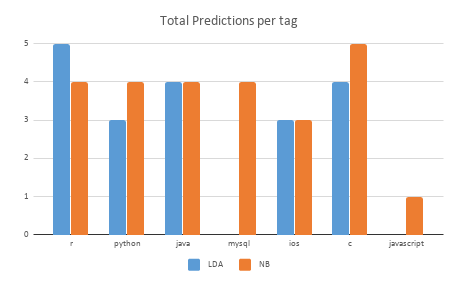
Some interesting aspects gathered out of the evaluation were:
- It can be seen that some of the javascript question are being classified as html by LDA which is quite true as titles will have a lot of similarities between javascript, jquery, html. On the otherside, naive bayes classifies them correctly.
- Another interesting part is when a question containing title belongs to ios (Tag) but it does not contain the tag in the title then classifier classifies it as android. By this, we can observe that android and ios have similarities. To add in the same way c and c++ are treated
7 Conclusion
Specifically stack overflow data is collection of rich set of attributes. With every step of cleaning the data, new possible features evolved. These features could be very helpful in being clear discriminators for tag prediction.However, we have used only textual features for our predictive modelling.
Also, as our data spans only 3 months and suffers a class imbalance problem, the inferences could be better by sampling data from a longer span and solving the class imbalance problem. Most of the correlations we set out to examine, suffered from this issue. Our results may not be conclusive for the stack overflow data overall.
There could be co-occuring technologies discussed as a part of the same question.We also would like to predict multiple tags for the question.
8 Future work
- We could not make use of the non-textual features for our modelling purpose. We could create an ensemble of classifiers. One of the classifiers could use the textual features and the another which leverages features like hasCode, hasLinks, score etc.
- Further analysis can help us learn which posts are good to train on. There are several factor based on which the scores of the question depends on. Discovering such interdependencies could help model our solution better.
- Also a direction could be chosen where we collect labels when experts are available to make the models continually better.
9 References
[Bhat et al] Bhat, V., Gokhale, A., Jadhav, R., Pudipeddi, J., & Akoglu, L. (2014, August). Min (e) d your tags: Analysis of question response time in stackoverflow. In Proceedings of the 2014 IEEE/ACM International Conference on Advances in Social Networks Analysis and Mining (pp. 328-335). IEEE Press.
[Joachims] Joachims, T. (1998, April). Text categorization with support vector machines: Learning with many relevant features. In European conference on machine learning (pp. 137-142). Springer, Berlin, Heidelberg.
[Basu et al] Basu, A., Walters, C., & Shepherd, M. (2003, January). Support vector machines for text categorization. In System Sciences, 2003. Proceedings of the 36th Annual Hawaii International Conference on (pp. 7-pp). IEEE.
[Ting et al] Ting, S. L., Ip, W. H., & Tsang, A. H. (2011). Is Naive Bayes a good classifier for document classification International Journal of Software Engineering and Its Applications, 5(3), 37-46.
[Forman et al] Forman, G. (2003). An extensive empirical study of feature selection metrics for text classification. Journal of machine learning research, 3(Mar), 1289-1305.
[Kaestner] Kaestner, C. A. A. (2013). Support vector machines and kernel functions for text processing. Revista de Informática Teórica e Aplicada, 20(3), 130-154.

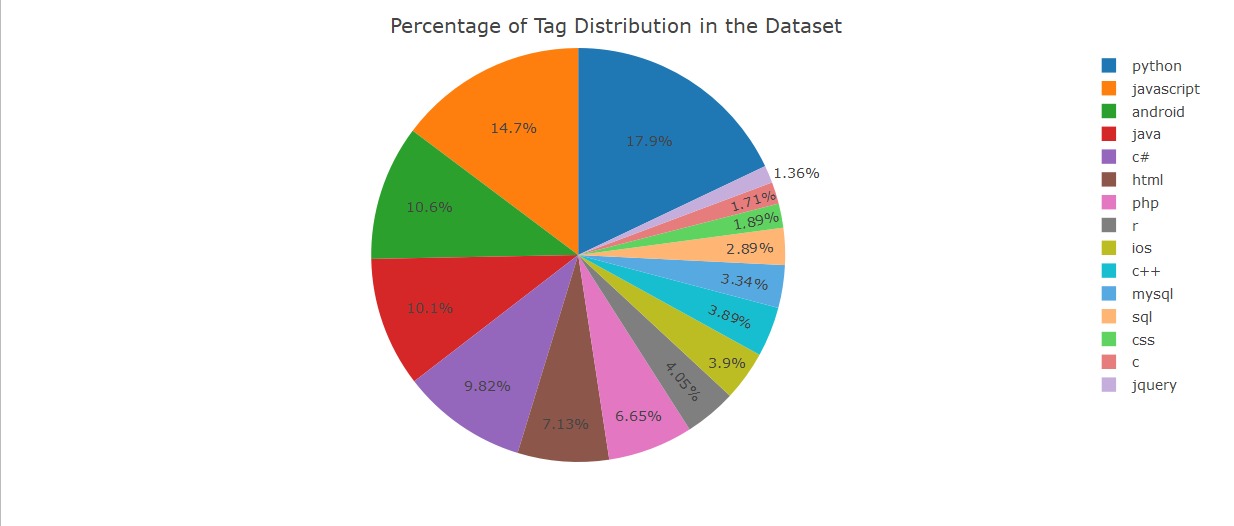
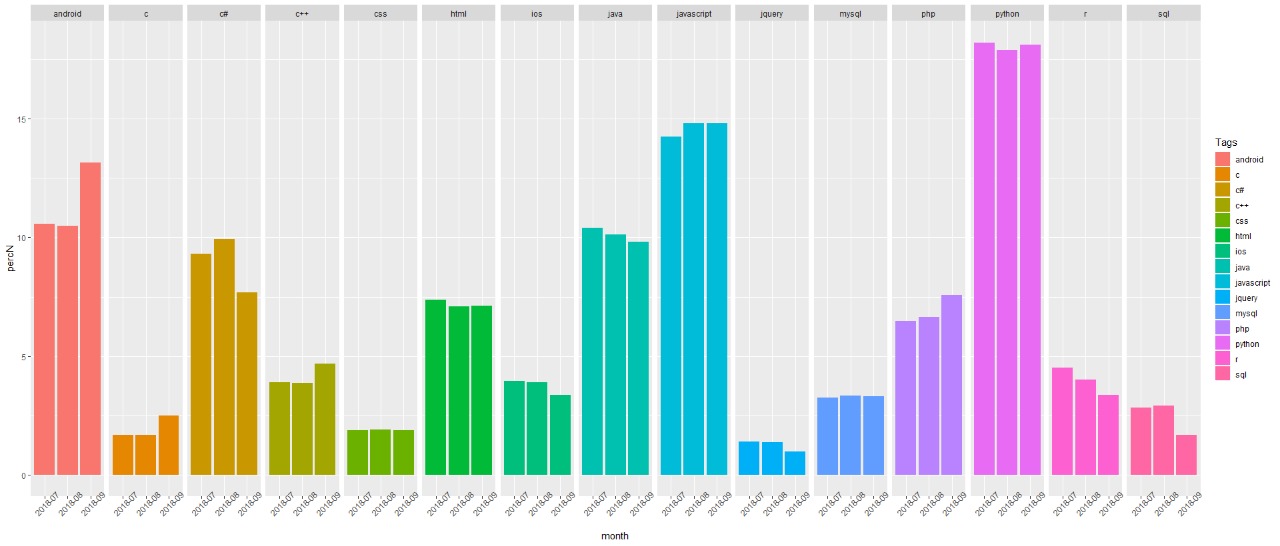


 This distribution is indicative of Sql and C being in use for a very long time and hence have larger user base. Understandably they are leading the average answer count ditsribution.
This distribution is indicative of Sql and C being in use for a very long time and hence have larger user base. Understandably they are leading the average answer count ditsribution.




 An example interpretation is C shows a positive association to negative scores meaning C questions tend to obtain negative scores more often than not. This could also indicate C questions are complex to understand or rather old and an answer might already be there in the platform.
An example interpretation is C shows a positive association to negative scores meaning C questions tend to obtain negative scores more often than not. This could also indicate C questions are complex to understand or rather old and an answer might already be there in the platform.
2.3.2 Comments.csv
The comments file has PostId as an attribute. We take only those entries in Comments.xml that have respective entries in Posts.xml. This way we remove those comments for which we don’t have the question in the Posts file. To match the comments with the PostIds using which we match the extracted PostID to get all the comments for the posts in consideration.
Similar to the processing for Posts, an XML parser in the R library “XML” was used to import the data into a DataFrame from Comments_new.xml. Then, the DataFrame was exported as a csv.